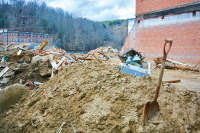Fire causes electrical failure in Haywood hospital
 The campus of Haywood Regional Medical Center is full of cars coming and going, staff walking toward or returning from shifts and people in workout gear heading toward the Fitness Center. Staff members help an elderly woman in a wheelchair get in her vehicle after discharging her from care, and staff working with those still admitted move between stations.
The campus of Haywood Regional Medical Center is full of cars coming and going, staff walking toward or returning from shifts and people in workout gear heading toward the Fitness Center. Staff members help an elderly woman in a wheelchair get in her vehicle after discharging her from care, and staff working with those still admitted move between stations.
All typical hospital scenes, except this one has a few extras: parked semis attached to portable emergency units, a stationary ambulance, an array of tan-colored tents, plenty of orange cones and a line of bright blue and pink portable toilets. And, underneath it all, a stretch of asphalt marked with white parking lines.
This is what the emergency room looks like when it’s forced to set up shop outside. Each Carolina MED-1 unit holds 13 beds, four of which are ICU-level, and is capable of supporting minor surgery, X-rays, ultrasounds, IV hookups and lab work. “A pretty phenomenal” resource, according to HRMC Chief Executive Officer Janie Sinacore-Jaberg, but when the hospital closes, it’s a necessary one.
The trouble began at 6:30 p.m. Thursday, June 19, when smoke was detected near the power room of the hospital. A small fire inside was soon found to be the cause, and within minutes first responders were on scene and the flames extinguished.
“It was in a switch,” said Johnny Glance, Haywood County Fire Marshal.
“They have several switches that the power comes into from the outside, and it handles different things in the hospital, and one of the switches burned up.”
Related Items
An abundance of departments showed up to respond to the small fire — Junaluska Fire Department, Maggie Valley Fire Department, Canton Fire Department, North Canton Fire Department, Clyde Fire Department, Crabtree-Iron Duff Fire Department, Haywood County Rescue Squad, Haywood County Emergency Medical Services, Haywood County Emergency Management, Haywood County Fire Marshal and Haywood County Sherriff’s Office — but while the fire was quickly extinguished, its effects were not.
The fire had damaged the hospital’s main power switch. The emergency generator came on when the power went out, restoring electricity, but the air conditioning still wasn’t working. When you’re a facility dedicated to caring for people whose health is in a delicate situation, sweltering in the heat is not an option.
“Because of the electrical damage inside our main switch, we felt it was better to move our patients,” Sinacore-Jaberg said in an address to Haywood County’s elected officials at a June 23 Council of Governments meeting.
Within four hours of discovering the fire, HRMC had begun transferring its 62 patients in the main hospital to other facilities, sending about half to MedWest-Harris Regional Hospital in Sylva and half to Mission Health in Asheville. Some of these patients had been receiving care in the psychiatric wing, and they were sent to one of several medical facilities in the region, according to HRMC spokeswoman Christina Deidesheimer.
“There are several regional facilities, to the best of my knowledge, that are capable,” Deidesheimer said.
Greg Shuping, emergency management director for Haywood County, oversaw the evacuation, which he termed “a historical event.”
“It’s a big deal,” Shuping said. “Especially in a community that only has one hospital.”
The response team took care to evacuate patients with serious conditions, such as those housed in the intensive care unit, first, and the evacuation ended without injury. The building did not suffer any structural damage, Sinacore-Jaberg said, and no foul play is suspected in causing the fire — likely, Sinacore-Jaberg said, it was caused by an “arcing of some kind.”
“Quick action really helped alleviate a lot of difficulties,” she said. “No one was injured. No one was hurt. And that we need to thank God for.”
Still, there’s no question this was an unusual event, to say the least. Hospital evacuations are far from everyday occurrences, and Shuping doesn’t know of any hospital in the state that’s had a similar situation.
“The only one we can find is there’s this one little hospital down on the coast that’s got a census of like 20 people that evacuates every time there’s a big hurricane,” Shuping said.
Helping hospitals
According to Lucretia Stargell, spokeswoman for Harris Regional Hospital, the process went smoothly on the receiving end.
“It’s been very calm. It’s been very collegial,” Stargell said.
On Friday, Harris Hospital received 30 patients from HRMC, with that number ebbing and flowing in the days since. As of Monday, Harris Hospital had received two intensive care patients total from Haywood, and had 10 currently admitted patients..
When the evacuation first started, the influx of patients put Harris Hospital’s census far upwards of average, with 70 of its 86 beds filled. On an average day, Stargell said, a few more than 50 beds would be filled, with that number usually rising to 60 or so when flu season hits. However, thanks to a lot of hard work and collaboration with HRMC physicians, the influx went smoothly.
“It does appear that everyone is focused on the patient, and that seems to be the top priority. Patient care is the top focus, so everyone is doing what they need to do to make sure that the patient is cared for without disruption,” Stargell said. “Everyone just kind of jumped in and did what they needed to do to care for that number of patients.”
Harris Regional Hospital gave emergency credentials to about 30 Haywood County physicians who normally practice at HRMC, allowing them to work in the hospital and care for Haywood patients whose cases they can then follow the whole way through. Normally, the credentialing process takes weeks, but it can speed up in emergency cases like this.
“Seventy [patients] is a large number, but it was very manageable because of the contributions from the Haywood staff, and our staff was prepared,” Stargell said.
Stargell said the hospital has also seen an increase in emergency room visits, though it’s hard to quantify what portion of the visits can be attributed to the Haywood hospital closure.
“Our [emergency department] volume at Harris is up,” she said. “It is difficult to say, though, how many of those are Haywood patients using our ED specifically because of the event at Haywood.”
By Sunday, HRMC had fully transitioned to a mobile emergency room, though the hospital encouraged people in need of emergency care to visit urgent care centers in Hazelwood and Canton if possible. That’s not always possible, though, and the mobile center has remained quite busy, Sinacore-Jaberg said.
“When you need us,” she said, “you need us.”
As of press time, that’s still the status, and there’s no clear timeline for moving forward. The hospital has electrical engineers looking at the switchboard, trying to figure out what went wrong, and the hospital’s doors will remain closed until that question is answered and its answer returned with a solution.
“We have lots of testing to continue,” Sinacore-Jaberg said. “The one thing I will promise you is that until I am perfectly sure that all of these electrical issues have been [addressed], we will stay as we are.”
Effects on the buyout
Status quo is not in the hospital’s future, however. HRMC is currently at the tail end of a buyout deal with Duke LifePoint Healthcare. The company has agreed to a price tag of $26 million, but there’s still time to back out. According to Sinacore-Jaberg, that’s not going to happen.
“Duke LifePoint is 100 and a million percent committed to moving forward with this acquisition,” she said. “This did not scare them. They went through [Hurricane] Katrina. They know these kinds of things happen.”
The sale is slated to be final by late July or early August, but that timeframe will likely get pushed back a bit — though not because of the fire and evacuation, Sinacore-Jaberg said.
Initially, the timeline had called for Duke LifePoint’s purchase of HRMC as well as WestCare in Sylva and Bryson City to be official by late March, so the buyout is already lagging behind the initial target.
“It’s not even because of this, but we still have some documents we have to get approved, so that might change our timeline a little bit, but they are still committed to moving forward,” Sinacore-Jaberg said.
The closure will likely change the final dollar amount the county sees from the sale. HRMC is a public hospital, a status that dates back to a publicly-backed construction bond in the 1970s. When the sale is complete, the county will receive the money paid, less any outstanding debts and expenses. The total payout to the county had been estimated somewhere in the neighborhood of $8 million, but the closure will likely have a negative impact on that number.
“Right now they have no one staying in the hospital, so there’s no income,” said Haywood County Commissioner Mike Sorrells. “It’s going to impact. We just don’t know how much of an impact it will be.”
Whether it’s out-of-pocket repair expenses or lost revenue due to closed doors, the hospital is likely to lose money as a result of the fire. If that’s the case, the hospital will have to tap what cash it has on hand to cover the loss, which in turn would whittle away at the sum the county gets back.
But there are a lot of moving parts at work that make specific figures hard to pin down. There’s the lost revenue itself, which is hard to put a finger on and will depend on exactly how long the hospital stays closed. There’s the insurance, which Sinacore-Jaberg said will take care of some of the loss, perhaps all of it or perhaps just a minimal amount. And there’s the cost of repair, which will depend on what exactly the damage is assessed.
Until some of those questions are answered — principally, the cause-and-repair question — the hospital will stay closed, revenue will continue to slip away and patients will continue to be funneled to neighboring hospitals.
“If you pray,” Sinacore-Jaberg said, “please pray that we get through this very quickly.”
It’s not all closed
The main hospital building at Haywood Regional Medical Center is the only facility affected by the fire and subsequent electrical issues. Other buildings, including the Health & Fitness Center, Outpatient Care Center, Homestead Hospice and doctors’ practices, are still open and running.
The hospital is encouraging people to maintain their normal workout routines and to keep their appointments unless a physician advises them otherwise.









